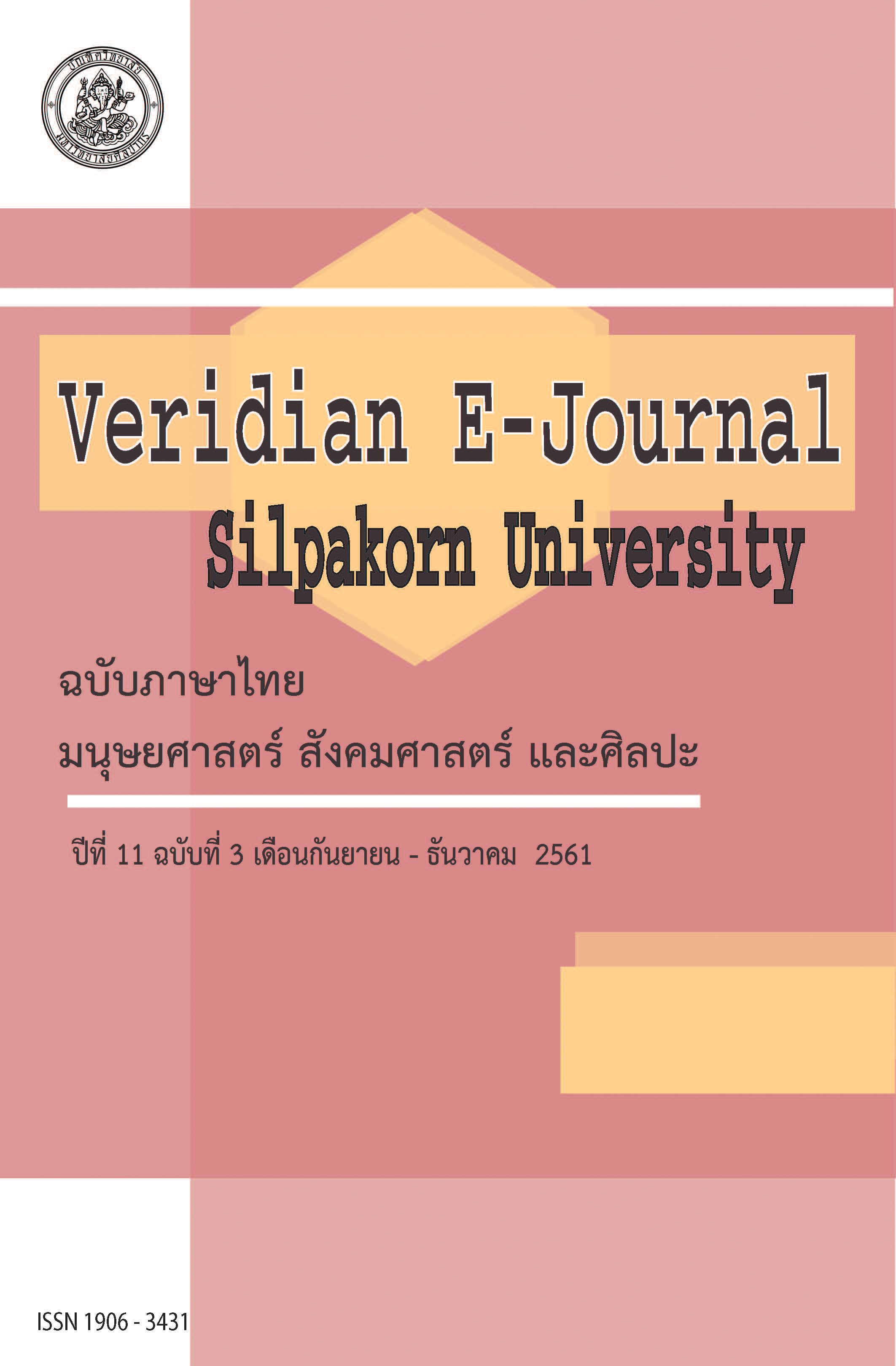การสร้างสรรค์จิตรกรรมสื่อประสมของศิลปินแห่งชาติสาขาทัศนศิลป์ ระหว่างปี พ.ศ. 2520-2559 (A Creative Production of Mixed Media Paintings by Thai National Artists in the Field of Visual Arts Between 1977 and 2016)
Main Article Content
Abstract
งานวิจัยมีวัตถุประสงค์เพื่อศึกษาประสบการณ์การดำเนินชีวิต แนวคิดและรูปแบบในการสร้างสรรค์ผลงานจิตรกรรมสื่อประสมของศิลปินแห่งชาติสาขาทัศนศิลป์ด้านสื่อประสม ซึ่งทั้งหมดมีรายนามอยู่ 3 ท่าน ได้แก่ ดร. กมล ทัศนาญชลี ศิลปินแห่งชาติสาขาทัศนศิลป์ (จิตรกรรมและสื่อผสม) ประจำปี พ.ศ. 2540 ศาสตราจารย์ เดชา วราชุน ศิลปินแห่งชาติสาขาทัศนศิลป์ (ภาพพิมพ์และสื่อผสม) ประจำปี พ.ศ. 2550 และ ศาสตราจารย์ วิโชค มุกดามณี ศิลปินแห่งชาติสาขาทัศนศิลป์ (สื่อผสม) ประจำปี พ.ศ. 2555 โดยศึกษาจากผลงานสร้างสรรค์ที่มีลักษณะเด่นของศิลปินแต่ละท่าน ท่านละจำนวน 10 ผลงาน ศึกษาจากเอกสาร งานวิจัย และการสัมภาษณ์ศิลปินกรณีศึกษา โดยผู้วิจัยใช้แนวคิดของการสร้างภาพแทน (Representation) แบบหลังสมัยใหม่ อันว่าด้วยเรื่องของการประกอบสร้าง (Constructionist Approach) และการวิเคราะห์ด้วยทฤษฏีสัญญะวิทยา (Semiological Analysis) เป็นเครื่องมือในการถอดรหัสคุณค่า ความหมายและความงามที่นอกเหนือไปจากองค์ประกอบทางศิลปะ
ผลจากการศึกษาพบว่า การสร้างสรรค์งานจิตรกรรมสื่อประสมของศิลปินกรณีศึกษาเป็นรูปแบบหนึ่งของการผนวกเอาวัตถุในวิถีชีวิตประจำวันและวัตถุจากสังคมวัฒนธรรมเข้าไปผสมผสานในงานศิลปะซึ่งแสดงให้เห็นการคาบเกี่ยวไปสู่การแสดงออกตามแนวคิดแบบหลังสมัยใหม่ การผสมผสานวัตถุและวัสดุเข้าไปใน การสร้างสรรค์ศิลปะนำไปสู่การสร้างอัตลักษณ์ (Originality)ในผลงานของศิลปิน วัตถุและวัสดุในฐานะของสัญญะ (Sign) ได้รับการให้คุณค่าและความหมายใหม่ด้วยวิธีการสร้างความสัมพันธ์ในรูปแบบต่างๆ ดังนี้ 1) แนวคิดเรื่องความสัมพันธ์แบบคู่ตรงข้าม (Binary Opposition) นำมาสู่การใช้สิ่งที่มีความขัดแย้งกันที่มีความสัมพันธ์แบบคู่ตรงข้ามกันมาเข้าคู่กัน 2) การสร้างความสัมพันธ์ ระหว่างตัวบท (Text) และปริบท (Context) ซึ่งนำมาสู่วิธีการที่ศิลปินทำให้ความหมายของวัตถุเปลี่ยนแปลง 3) แนวคิดเรื่องความสัมพันธ์ระหว่างตัวหมาย (Signifier) และตัวหมายถึง (Signified) นำมาสู่การทำให้ภาพสื่อความหมายจากการกำหนดระยะและมุมมอง 4) แนวคิดของการให้ส่วนหนึ่งของสัญญะสื่อความหมายเชื่อมโยงสัมพันธ์ไปถึงความหมายส่วนรวมที่เป็นหน่วยใหญ่ 5) แนวคิดเรื่องการถ่ายทอดความหมายโดยอรรถและความหมายโดยนัย และ 6) แนวคิดเรื่องการใช้สัญลักษณ์สากล ซึ่งไม่ได้มีความหมายอ้างอิงถึงของจริงอย่างใดอย่างหนึ่งเฉพาะ
This research focuses on the mixed media artworks of three Thai artists, namely Kamol Tassananchalee, national visual artist in the year 1997 (for fine art and mixed media work) Decha Varachun, national visual artist of 2007 (for print and mixed media work) and Vichoke Mukdamanee, national visual artist of 2012 (mixed media work). This research aims to study their life experiences, their way of thinking and resulting artistic style during the years 1977- 2016. This will be approached firstly by examining ten of each artists’ well known works, while also studying documentation, written research and artist interviews. Additionally, the researcher approaches the artworks with a background of post modern representation which relates to Constructionist Approach alongside Semiological Analysis in order to decode composition, artistic values and meaning, and aesthetics.
The resulting study revealed that the creative process of making mixed media artworks in the three case study artists had some similarities. For example, they all integrated everyday and mass cultural objects into the artworks, essentially a very postmodern expression. The mixing of medium and objects created the originality in their artworks. Objects and materials in the artwork were represented as a Sign, their value and meaning came about by relating different elements together, including the following:
1) The concept of binary opposites, which combines contrasting elements together, helping to create clearer meaning through the juxtaposition of two differing elements.
2) Creating a relationship between Text and Context, and in the process bringing a new dimension of meaning to an object.
3) The concept of a relation between Signifier and Signified, leading to a communicating method by focusing on distance and perspective.
4) Thinking how part of a Sign’s meaning can be linked to a larger meaning.
5) Communicating meaning in a denotative and connotative way.
6) The concept of universal symbolism which does need to reference anything in particular.
